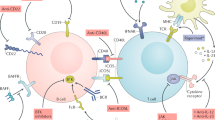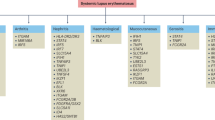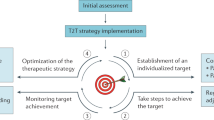Abstract
For the first time in more than 50 years, the US Food and Drug Administration has approved a drug specifically for the treatment of systemic lupus erythematosus (SLE). This drug, belimumab (Benlysta), is a human monoclonal antibody that neutralizes the B-cell survival factor, B-lymphocyte stimulator (BLyS). The approval of belimumab combined a pioneering approach to genomics-based gene discovery, an astute appreciation of translational medicine, a disciplined clinical strategy, a willingness to take calculated risks, a devoted cadre of patients and physicians and a healthy dose of serendipity. Collectively, these efforts have provided a model for the development of a new generation of drugs to treat the broad manifestations of SLE. However, as a substantial percentage of SLE patients do not respond to belimumab, further research is needed to better characterize the pathogenetic mechanisms of SLE, identify additional therapeutic targets, and develop effective and nontoxic novel agents against these targets.
This is a preview of subscription content, access via your institution
Access options
Subscribe to this journal
Receive 12 print issues and online access
$209.00 per year
only $17.42 per issue
Buy this article
- Purchase on Springer Link
- Instant access to full article PDF
Prices may be subject to local taxes which are calculated during checkout



Similar content being viewed by others
References
Adams, M.D. et al. Initial assessment of human gene diversity and expression patterns based upon 83 million nucleotides of cDNA sequence. Nature 377 (suppl.), 3–174 (1995).
International Publication Number WO 98/18921 published on May 7, 1998, corresponding to International Application Number PCT/US96/17957, filed October 25, 1996.
Moore, P.A. et al. BLyS: member of the tumor necrosis factor family and B lymphocyte stimulator. Science 285, 260–263 (1999).
Shu, H.-B., Hu, W.-H. & Johnson, H. TALL-1 is a novel member of the TNF family that is down-regulated by mitogens. J. Leukoc. Biol. 65, 680–683 (1999).
Mukhopadhyay, A., Ni, J., Zhai, Y., Yu, G.-L. & Aggarwal, B.B. Identification and characterization of a novel cytokine, THANK, a TNF homologue that activates apoptosis, nuclear factor-κB, and c-Jun NH2-terminal kinase. J. Biol. Chem. 274, 15978–15981 (1999).
Schneider, P. et al. BAFF, a novel ligand of the tumor necrosis factor family, stimulates B cell growth. J. Exp. Med. 189, 1747–1756 (1999).
Tribouley, C. et al. Characterization of a new member of the TNF family expressed on antigen presenting cells. Biol. Chem. 380, 1443–1447 (1999).
Gross, J.A. et al. TACI-Ig neutralizes molecules critical for B cell development and autoimmune disease: impaired B cell maturation in mice lacking BLyS. Immunity 15, 289–302 (2001).
Schiemann, B. et al. An essential role for BAFF in the normal development of B cells through a BCMA-independent pathway. Science 293, 2111–2114 (2001).
Yu, G. et al. APRIL and TALL-1 and receptors BCMA and TACI: system for regulating humoral immunity. Nat. Immunol. 1, 252–256 (2000).
Yan, M. et al. Identification of a receptor for BLyS demonstrates a crucial role in humoral immunity. Nat. Immunol. 1, 37–41 (2000).
Xia, X.-Z. et al. TACI is a TRAF-interacting receptor for TALL-1, a tumor necrosis factor family member involved in B cell regulation. J. Exp. Med. 192, 137–144 (2000).
Khare, S.D. et al. Severe B cell hyperplasia and autoimmune disease in TALL-1 transgenic mice. Proc. Natl. Acad. Sci. USA 97, 3370–3375 (2000).
Do, R.K.G. et al. Attenuation of apoptosis underlies B lymphocyte stimulator enhancement of humoral immune response. J. Exp. Med. 192, 953–964 (2000).
Stewart, D.M., McAvoy, M.J., Hilbert, D.M. & Nelson, D.L. B lymphocytes from individuals with common variable immunodeficiency respond to B lymphocyte stimulator (BLyS protein) in vitro. Clin. Immunol. 109, 137–143 (2003).
Knight, A.K. et al. High serum levels of BAFF, APRIL, and TACI in common variable immunodeficiency. Clin. Immunol. 124, 182–189 (2007).
Mackay, F. et al. Mice transgenic for BAFF develop lymphocytic disorders along with autoimmune manifestations. J. Exp. Med. 190, 1697–1710 (1999).
Gross, J.A. et al. TACI and BCMA are receptors for a TNF homologue implicated in B-cell autoimmune disease. Nature 404, 995–999 (2000).
Zhang, J. et al. Cutting edge: a role for B lymphocyte stimulator in systemic lupus erythematosus. J. Immunol. 166, 6–10 (2001).
Cheema, G.S., Roschke, V., Hilbert, D.M. & Stohl, W. Elevated serum B lymphocyte stimulator levels in patients with systemic immune-based rheumatic diseases. Arthritis Rheum. 44, 1313–1319 (2001).
Thompson, J.S. et al. BAFF binds to the tumor necrosis factor receptor-like molecule B cell maturation antigen and is important for maintaining the peripheral B cell population. J. Exp. Med. 192, 129–136 (2000).
Batten, M. et al. BAFF mediates survival of peripheral immature B lymphocytes. J. Exp. Med. 192, 1453–1466 (2000).
Lesley, R. et al. Reduced competitiveness of autoantigen-engaged B cells due to increased dependence on BAFF. Immunity 20, 441–453 (2004).
Thien, M. et al. Excess BAFF rescues self-reactive B cells from peripheral deletion and allows them to enter forbidden follicular and marginal zone niches. Immunity 20, 785–798 (2004).
Ota, M. et al. Regulation of the B cell receptor repertoire and self-reactivity by BAFF. J. Immunol. 185, 4128–4136 (2010).
Nikbakht, N., Migone, T.-S., Ward, C.P. & Manser, T. Cellular competition independent of BAFF/B lymphocyte stimulator results in low frequency of an autoreactive clonotype in mature polyclonal B cell compartments. J. Immunol. 187, 37–46 (2011).
Carson, K.R. et al. Progressive multifocal leukoencephalopathy after rituximab therapy in HIV-negative patients: a report of 57 cases from the Research on Adverse Drug Events and Reports project. Blood 113, 4834–4840 (2009).
Fillatreau, S., Sweenie, C.H., McGeachy, M.J., Gray, D. & Anderton, S.M. B cells regulate autoimmunity by provision of IL-10. Nat. Immunol. 3, 944–950 (2002).
Matsushita, T., Yanaba, K., Bouaziz, J.-D., Fujimoto, M. & Tedder, T.F. Regulatory B cells inhibit EAE initiation in mice while other B cells promote disease progression. J. Clin. Invest. 118, 3420–3430 (2008).
Haas, K.M. et al. Protective and pathogenic roles for B cells during systemic autoimmunity in NZB/W F1 mice. J. Immunol. 184, 4789–4800 (2010).
Watanabe, R. et al. Regulatory B cells (B10 cells) have a suppressive role in murine lupus: CD19 and B10 cell deficiency exacerbates systemic autoimmunity. J. Immunol. 184, 4801–4809 (2010).
Iwata, Y. et al. Characterization of a rare IL-10-competent B-cell subset in humans that parallels mouse regulatory B10 cells. Blood 117, 530–541 (2011).
Huard, B., Schneider, P., Mauri, D., Tschopp, J. & French, L.E. T cell costimulation by the TNF ligand BAFF. J. Immunol. 167, 6225–6231 (2001).
Ng, L.G. et al. B cell-activating factor belonging to the TNF family (BAFF)-R is the principal BAFF receptor facilitating BAFF costimulation of circulating T and B cells. J. Immunol. 173, 807–817 (2004).
Sutherland, A.P.R. et al. BAFF augments certain Th1-associated inflammatory responses. J. Immunol. 174, 5537–5544 (2005).
Zhou, X. et al. BAFF promotes Th17 cells and aggravates experimental autoimmune encephalomyelitis. PLoS ONE 6, e23629 (2011).
Jacob, N. et al. Accelerated pathological and clinical nephritis in systemic lupus erythematosus-prone New Zealand Mixed 2328 mice doubly deficient in TNF receptor 1 and TNF receptor 2 via a Th17-associated pathway. J. Immunol. 182, 2532–2541 (2009).
Zhang, Z., Kyttaris, V.C. & Tsokos, G.C. The role of IL-23/IL-17 axis in lupus nephritis. J. Immunol. 183, 3160–3169 (2009).
Baker, K.P. et al. Generation and characterization of LymphoStat-B, a human monoclonal antibody that antagonizes the bioactivities of B lymphocyte stimulator. Arthritis Rheum. 48, 3253–3265 (2003).
Halpern, W. et al. Chronic administration of belimumab, a BLyS antagonist, decreases tissue and peripheral blood B-lymphocyte populations in cynomolgus monkeys: pharmacokinetic, pharmacodynamic and toxicologic effects. Toxicol. Sci. 91, 586–599 (2006).
Furie, R. et al. Biologic activity and safety of belimumab, a neutralizing anti-B-lymphocyte stimulator (BLyS) monoclonal antibody: a phase I trial in patients with systemic lupus erythematosus. Arthritis Res. Ther. 10, R109 (2008).
Petri, M. et al. Association of plasma B lymphocyte stimulator levels and disease activity in systemic lupus erythematosus. Arthritis Rheum. 58, 2453–2459 (2008).
Collins, C.E. et al. B lymphocyte stimulator (BLyS) isoforms in systemic lupus erythematosus: disease activity correlates better with blood leukocyte BLyS mRNA levels than with plasma BLyS protein levels. Arthritis Res. Ther. 8, R6 (2006).
Becker-Merok, A., Nikolaisen, C. & Nossent, H.C. B-lymphocyte activating factor in systemic lupus erythematosus and rheumatoid arthritis in relation to autoantibody levels, disease measures and time. Lupus 15, 570–576 (2006).
Ju, S. et al. Correlation of the expression levels of BLyS and its receptors mRNA in patients with systemic lupus erythematosus. Clin. Biochem. 39, 1131–1137 (2006).
Marsters, S.A. et al. Interaction of the TNF homologues BLyS and APRIL with the receptor homologues BCMA and TACI. Curr. Biol. 10, 785–788 (2000).
Wu, Y. et al. Tumor necrosis factor (TNF) receptor superfamily member TACI is a high affinity receptor for TNF family members APRIL and BLyS. J. Biol. Chem. 275, 35478–35485 (2000).
Rennert, P. et al. A soluble form of B cell maturation antigen, a receptor for the tumor necrosis factor family member APRIL, inhibits tumor cell growth. J. Exp. Med. 192, 1677–1684 (2000).
Thompson, J.S. et al. BAFF-R, a novel TNF receptor that specifically interacts with BAFF. Science 293, 2108–2111 (2001).
Yan, M. et al. Identification of a novel receptor for B lymphocyte stimulator that is mutated in a mouse strain with severe B cell deficiency. Curr. Biol. 11, 1547–1552 (2001).
Varfolomeev, E. et al. APRIL-deficient mice have normal immune system development. Mol. Cell. Biol. 24, 997–1006 (2004).
Castigli, E. et al. Impaired IgA class switching in APRIL-deficient mice. Proc. Natl. Acad. Sci. USA 101, 3903–3908 (2004).
Benson, M.J. et al. Cutting edge: the dependence of plasma cells and independence of memory B cells on BAFF and APRIL. J. Immunol. 180, 3655–3659 (2008).
Belnoue, E. et al. APRIL is critical for plasmablast survival in the bone marrow and poorly expressed by early-life bone marrow stromal cells. Blood 111, 2755–2764 (2008).
Roschke, V. et al. BLyS and APRIL form biologically active heterotrimers that are expressed in patients with systemic immune-based rheumatic diseases. J. Immunol. 169, 4314–4321 (2002).
Carbonatto, M. et al. Nonclinical safety, pharmacokinetics, and phamcodynamics of atacicept. Toxicol. Sci. 105, 200–210 (2008).
Dall'Era, M. et al. Reduced B lymphocyte and immunoglobulin levels after atacicept treatment in patients with systemic lupus erythematosus: results of a multicenter, phase Ib, double-blind, placebo-controlled, dose-escalating trial. Arthritis Rheum. 56, 4142–4150 (2007).
Belouski, S.S., Rasmussen, H.E., Thomas, J.K., Ferbas, J. & Zack, D.J. Changes in B cells and B cell subsets induced by BAFF neutralization in vivo. Arthritis Rheum. 56, S565 (2007).
Sabahi, R. et al. Immunologic effects of BAFF antagonism in the treatment of human SLE. Arthritis Rheum. 56, S566 (2007).
Kayagaki, N. et al. BAFF/BLyS receptor 3 binds the B cell survival factor BAFF ligand through a discrete surface loop and promotes processing of NF-κB2. Immunity 17, 515–524 (2002).
Vugmeyster, Y. et al. A soluble BAFF antagonist, BR3-Fc, decreases peripheral blood B cells and lymphoid tissue marginal zone and follicular B cells in cynomolgus monkeys. Am. J. Pathol. 168, 476–489 (2006).
Cragg, M.S., Walshe, C.A., Ivanov, A.O. & Glennie, M.J. The biology of CD20 and its potential as a target for mAb therapy. Curr. Dir. Autoimmun. 8, 140–174 (2005).
Edwards, J.C.W. et al. Efficacy of B-cell-targeted therapy with rituximab in patients with rheumatoid arthritis. N. Engl. J. Med. 350, 2572–2581 (2004).
Leandro, M.J., Edwards, J.C., Cambridge, G., Ehrenstein, M.R. & Isenberg, D.A. An open study of B lymphocyte depletion in systemic lupus erythematosus. Arthritis Rheum. 46, 2673–2677 (2002).
Looney, R.J. et al. B cell depletion as a novel treatment for systemic lupus erythematosus: a phase I/II dose-escalation trial of rituximab. Arthritis Rheum. 50, 2580–2589 (2004).
Wang, H. et al. TACI-ligand interactions are required for T cell activation and collagen-induced arthritis in mice. Nat. Immunol. 2, 632–637 (2001).
McKay, J. et al. Belimumab (BmAb), a fully human monoclonal antibody to B-lymphocyte stimulator (BLyS), combined with standard of care therapy reduces the signs and symptoms of rheumatoid arthritis in a heterogeneous subject population. Arthritis Rheum. 52, S710–S711 (2005).
Stohl, W. et al. Belimumab (BmAb), a novel fully human monoclonal antibody to B-lymphocyte stimulator (BLyS), selectively modulates B-cell sub-populations and immunoglobulins in a heterogeneous rheumatoid arthritis subject population. Arthritis Rheum. 52, S444 (2005).
Wallace, D.J. et al. A phase II, randomized, double-blind, placebo-controlled, dose-ranging study of belimumab in patients with active systemic lupus erythematosus. Arthritis Rheum. 61, 1168–1178 (2009).
Furie, R.A. et al. Novel evidence-based systemic lupus erythematosus responder index. Arthritis Rheum. 61, 1143–1151 (2009).
Navarra, S.V. et al. Efficacy and safety of belimumab in patients with active systemic lupus erythematosus: a randomised, placebo-controlled, phase 3 trial. Lancet 377, 721–731 (2011).
Furie, R. et al. A phase III, randomized, placebo-controlled study of belimumab, a monoclonal antibody that inhibits B lymphocyte stimulator, in patients with systemic lupus erythematosus. Arthritis Rheum. 63, 3918–3930 (2011).
Merrill, J.T. et al. Efficacy and safety of rituximab in moderately-to-severely active systemic lupus erythematosus: the randomized, double-blind, phase II/III systemic lupus erythematosus evaluation of rituximab trial. Arthritis Rheum. 62, 222–233 (2010).
Furie, R. et al. Efficacy and safety of rituximab in subjects with active proliferative lupus nephritis (LN): results from the randomized, double-blind phase III LUNAR study. Arthritis Rheum. 60, S429 (2009).
Ramos-Casals, M., Díaz-Lagares, C. & Khamashta, M.A. Rituximab and lupus: good in real life, bad in controlled trials. Comment on the article by Lu et al. Arthritis Rheum. 61, 1281–1282 (2009).
Looney, R.J. B cell-targeted therapies for systemic lupus erythematosus: an update on clinical trial data. Drugs 70, 529–540 (2010).
Ramanujam, M. et al. Similarities and differences between selective and nonselective BAFF blockade in murine SLE. J. Clin. Invest. 116, 724–734 (2006).
Jacob, C.O. et al. Paucity of clinical disease despite serological autoimmunity and kidney pathology in lupus-prone New Zealand Mixed 2328 mice deficient in BAFF. J. Immunol. 177, 2671–2680 (2006).
Shlomchik, M.J., Madaio, M.P., Ni, D., Trounstein, M. & Huszar, D. The role of B cells in lpr/lpr-induced autoimmunity. J. Exp. Med. 180, 1295–1306 (1994).
Jacob, N. et al. B cell and BAFF dependence of IFN-α-exaggerated disease in systemic lupus erythematosus-prone NZM 2328 mice. J. Immunol. 186, 4984–4993 (2011).
Acknowledgements
The authors thank T.-S. Migone and W. Freimuth of HGS for helpful discussions and assistance with the time line. The work was supported in part by NIH grant R01 AR050193 to W.S.
Author information
Authors and Affiliations
Corresponding author
Ethics declarations
Competing interests
W.S. received clinical trials support from Human Genome Sciences. D.M.H. is a former employee of Human Genome Sciences and a current employee of Zyngenia.
Rights and permissions
About this article
Cite this article
Stohl, W., Hilbert, D. The discovery and development of belimumab: the anti-BLyS–lupus connection. Nat Biotechnol 30, 69–77 (2012). https://doi.org/10.1038/nbt.2076
Received:
Accepted:
Published:
Issue Date:
DOI: https://doi.org/10.1038/nbt.2076
This article is cited by
-
Peli1 negatively regulates noncanonical NF-κB signaling to restrain systemic lupus erythematosus
Nature Communications (2018)
-
BAFF-neutralizing interaction of belimumab related to its therapeutic efficacy for treating systemic lupus erythematosus
Nature Communications (2018)
-
BAFF emerges from the genetic shadows
Nature Reviews Rheumatology (2017)
-
10 years of therapeutic advances in the rheumatic diseases
Nature Reviews Rheumatology (2015)
-
BLyS und Belimumab
Der Nephrologe (2014)



